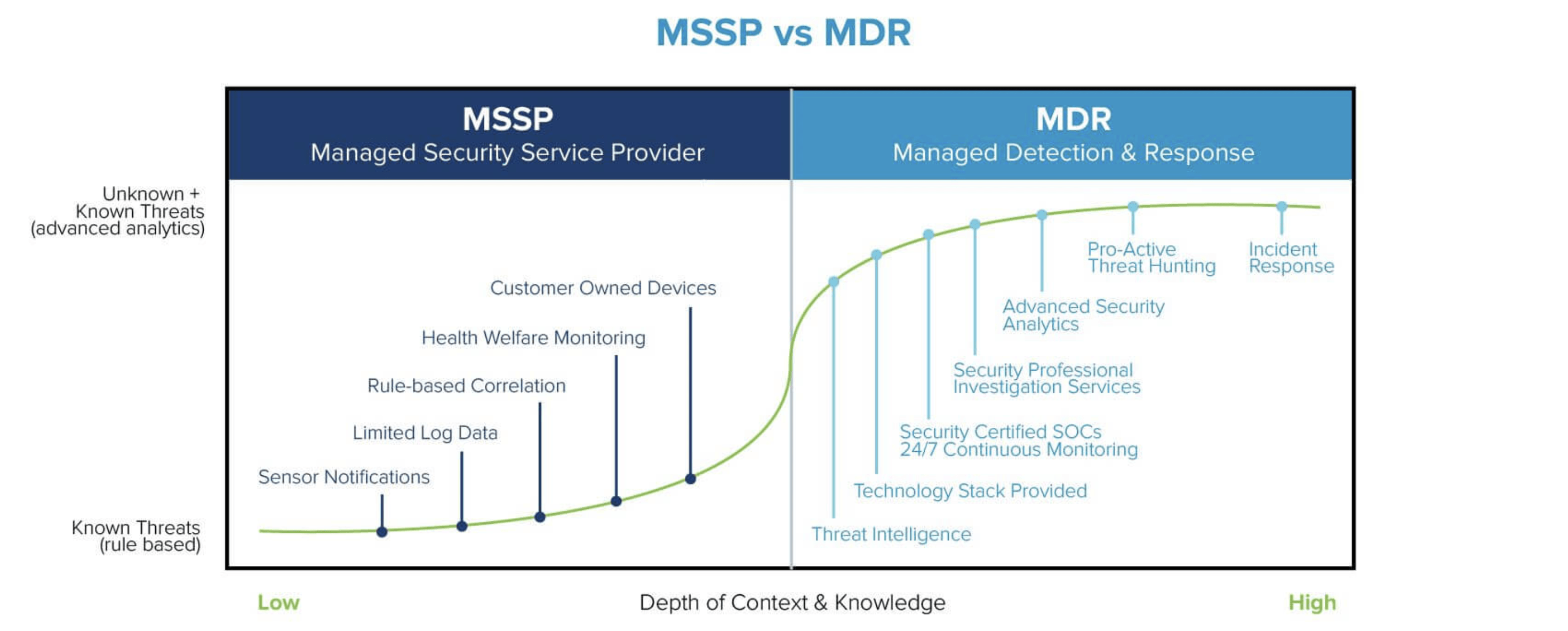Managed Detection & Response (MDR) vs. Managed Security Service Providers (MSSP) – Part 1
Introduction to Managed Detection and Response and Managed Security Service Providers
Companies face numerous choices in securing their digital infrastructure in the modern cybersecurity technology and services landscape. One critical decision is implementing Managed Detection and Response (MDR) or relying on a Managed Security Service Provider (MSSP). Each approach offers unique benefits: MSSPs generally manage essential security functions, while MDRs emphasize real-time detection, analysis, and immediate response to active threats. In this article, we’ll define each solution, examine their core differences, and discuss when each might be the best fit for different organizations.
Defining MDR and MSSP
What is MDR?
Managed Detection and Response (MDR) is a proactive cybersecurity service that combines advanced threat detection technologies with the expertise of skilled analysts. MDR solutions are designed to detect, analyze, and respond to active threats in real time, providing companies with a rapid response to minimize the damage from cyber incidents. MDR uses tools like Endpoint Detection and Response (EDR) to monitor systems and provides insight into potential security risks, delivering protection that extends far beyond traditional prevention methods.
Example: Consider a large financial institution that operates 24/7 and handles sensitive customer data. Such a company could face continuous phishing, ransomware, and malware attacks. An MDR service would enable it to monitor around-the-clock, ensuring that even advanced and emerging threats are detected and neutralized promptly, protecting customer data and meeting regulatory standards.
What is a MSSP?
Managed Security Service Providers (MSSPs) offer outsourced cybersecurity management, focusing primarily on the operational aspects of security like maintaining firewalls, performing vulnerability scans, managing antivirus solutions, and providing network monitoring. MSSPs can significantly reduce an organization’s need to hire and train internal security staff, allowing companies to establish a robust baseline of security without the complexity and cost of an internal Security Operations Center (SOC).
Example: A mid-sized healthcare provider bound by HIPAA compliance might use an MSSP to ensure continuous firewall monitoring, endpoint protection, and regular vulnerability assessments. With these preventive measures managed by the MSSP, the organization achieves HIPAA compliance and lowers the risk of basic cyber threats.

MDR and MSSP: Core Differences and Service Offerings
The differences between MDR and MSSP extend into the specific services they provide:
- Monitoring and Incident Response
- MSSP: MSSPs generally monitor network traffic and devices, sending alerts when anomalies occur. However, they typically do not investigate alerts or respond actively, leaving these tasks to the customer’s internal team.
- MDR: MDR provides full incident response services, including investigating alerts, reducing false positives, and initiating responses to neutralize threats as they are detected.
- Human Expertise and Forensics
- MSSP: MSSPs offer basic monitoring and management services but may not have the dedicated personnel needed for complex threat hunting or forensic investigations.
- MDR: MDR providers often employ specialized analysts who actively search for threats, use forensic tools to understand threat origins, and collaborate closely with clients for rapid remediation.
- Focus on Prevention vs. Response
- MSSP: Focuses on preventive measures like firewalls and antivirus, staying primarily on the “left of boom,” or the stage before an attack occurs.
- MDR: Actively operates on both “left of boom” and “right of boom” (post-attack), providing real-time detection and response capabilities.
Understanding “Left of Boom” vs. “Right of Boom”
In cybersecurity, the terms “left of boom” and “right of boom” highlight the timeline of a cyberattack. “Left of boom” represents the period before an attack, where preventive actions aim to stop attacks from occurring. MSSPs focus on this side of cybersecurity by building and maintaining a fortified perimeter.
“Right of boom” represents the period after an attack occurs, requiring detection, containment, and recovery actions. MDR shines here, providing a swift response to stop the spread of active threats.
Scenario: Imagine an e-commerce company. With an MSSP, it might prevent attacks by managing firewalls and filtering out known malicious sites. However, if a phishing attack slips through and installs malware, an MDR would be able to detect this breach in real time and respond to contain the threat, minimizing operational downtime.
Choosing the Right Solution – Part 1
While both MDR and MSSP serve as valuable cybersecurity resources, their applicability depends on organizational needs, industry regulations, and security goals.
- MSSP: Ideal for companies needing a cost-effective solution for routine security management and prevention.
- MDR: A better fit for companies facing high cybersecurity risks, especially if they lack internal security teams capable of handling active threat detection and response.
In Part 2, we’ll dive deeper into the benefits of each solution and explore a checklist to help you determine which service best aligns with your business needs.
To learn more about how Falcon Guard can assist with deciding cybersecurity solutions that are optimal for your organization, or if you suspect that you have been targeted by an attack, contact us at (858) 349-2610, or fill out our Contact Us form on our website.

